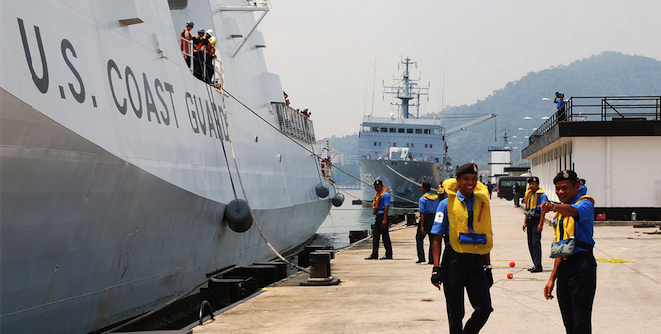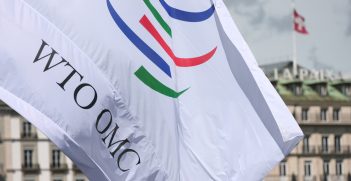The Growing Importance of White Hulls in Indian Ocean Security

The increasing challenges of the Indian Ocean are not simply limited to the navy’s grey hull ships. Coast guard white hulls also have a significant role to play in the security of the region.
Much of our attention on maritime security challenges is currently focused on the rise of China and territorial disputes in the Pacific. But the maritime security challenges that concern Indian Ocean states, and those that use the Indian Ocean, are for the most part quite different. These are a list of problems usually involving non-state actors: piracy; illegal fishing; smuggling of drugs, people and arms; humanitarian and disaster relief; and search and rescue. In the Indian Ocean these problems far outweigh the sort of state-based problems we are seeing in the South China Sea.
But when issues such as these come to the fore, as piracy did a decade or so ago, navies are usually the first agencies called upon to deal with them. Navies certainly have the capabilities. But while navies can and should play important roles in addressing these issues, we also need to be aware that it is not the primary role that they were built for. The principal mission of most navies is to defend their homelands against state-based threats, and not to act as an ocean-going police force or rescue service. The use of navies in this role can involve very expensive high-end equipment primarily designed for fighting wars. This is not always the optimal way of addressing threats. The international naval efforts to counter Somali-based pirates in the Arabian Sea is a good example. The effort involved a considerable waste of money as countries – many from outside our region – competed against each other to deploy expensive high-end vessels to counter what was essentially just a policing problem. In reality, the problem was largely addressed through placing private security guards on commercial ships.
But an even bigger problem is the political one. Because the primary purpose of naval “grey hulls” is to fight wars, many countries, especially in the Indian Ocean region, are very cautious about how much they cooperate on an operational level. For many countries this comes with significant political baggage. We saw this, for example, in Myanmar’s concerns about international offers of assistance following Cyclone Nargis in 2008.
This is not to say that there haven’t been important steps in naval cooperation in the Indian Ocean region. International naval efforts against piracy helped many navies learn to work better with each other, or at least alongside each other. The formation of the Indian Ocean Naval Symposium (IONS) in 2008 was a seminal step in the development of the Indian Ocean as a region, marking the first time that states from across the Indian Ocean have worked together to address security issues.
But we also need to accept that navy–navy cooperation will often be subject to serious limitations driven by cost and politics. This means that many countries will increasingly think about other ways of addressing maritime security challenges. This could involve a host of different approaches, but one likely change we will see in coming years is the increasing deployment of “white hull” coast guards and similar civilian agencies, often at great distances from their homelands.
In each case this will be driven by the best mix in terms of cost and effectiveness of naval and non-naval agencies. We have seen this debate in Australia over the last decade or so, resulting in the evolution of the Australian Border Force as an agency that coordinates white and grey hull assets to address certain maritime security issues. Every country will have slightly different answers to these problems, but a common theme is that in many cases white hull agencies will assume greater responsibilities and send their vessels further and further afield.
In many of these cases white hulls will increasingly overlap with functions traditionally carried out by navies. The disputes we are seeing in the East China Sea and South China Sea are now being played out more and more between white hulls, a decision taken by relevant governments for strong political reasons. We will probably see this trend only increase further in future years as white hull vessels take an ever greater share of responsibility for the provision of maritime security in the Indian Ocean, with the support of more traditional naval assets. Future anti-piracy efforts might, for example, include greater use of smaller white-hulled vessels with the support of traditional military information, surveillance, reconnaissance and logistics systems. This approach would not only save money but would also reduce the potential for naval rivalry. These practical realities will soon impact on the way maritime security is provided in the Indian Ocean.
It also means that we need to think about how white hull agencies will work together in the Indian Ocean. The Indian and Japanese coast guards have been conducting bilateral exercises off the coast of southern India for more than a decade, indicating the value those countries see in coast guard cooperation. We are seeing more and more visits of coast guard ships beyond their normal horizons, including the visit of an Indian coast guard ship to Australia. This bilateral cooperation among coast guard agencies will continue to grow.
But there is a gap at the multilateral level. Many of these challenges need to be addressed on a multilateral basis, and there is currently no mechanism or forum for cooperation among coast guard agencies in the Indian Ocean. The Heads of Asian Coast Guard Agencies Meeting currently brings together coast guard agencies along the Asian littoral from Japan to Pakistan, but there is no forum that is open to all Indian Ocean states and focuses on maritime issues that are particular to the Indian Ocean.
One hesitates before suggesting the creation of a new regional forum, but there is a real need in the Indian Ocean for a mechanism to support greater coordination and cooperation among coast guard agencies. Perhaps Australia should consider sponsoring an Indian Ocean forum of coast guards to act in parallel with IONS.
Alternatively we could start on a minilateral basis. For example, key states in the eastern Indian Ocean, such as India, Indonesia and Australia could consider establishing a minilateral mechanism for cooperation among their white hull agencies. This could be developed to include other key coast guard agencies from the eastern Indian Ocean and even help facilitate extra-regional countries contributing to capacity within the region.
However we do it, Australia needs to be thinking ahead of the curve in finding ways to address challenges in the Indian Ocean in a way that is cost effective and appropriate for the region.
Dr David Brewster is a visiting fellow at the National Security College at the Australian National University. This is an edited version of a paper presented at the Third Indian Ocean Dialogue held at Padang, Indonesia on 13–14 April 2016. This article is published under a Creative Commons Licence and may be republished with attribution.





